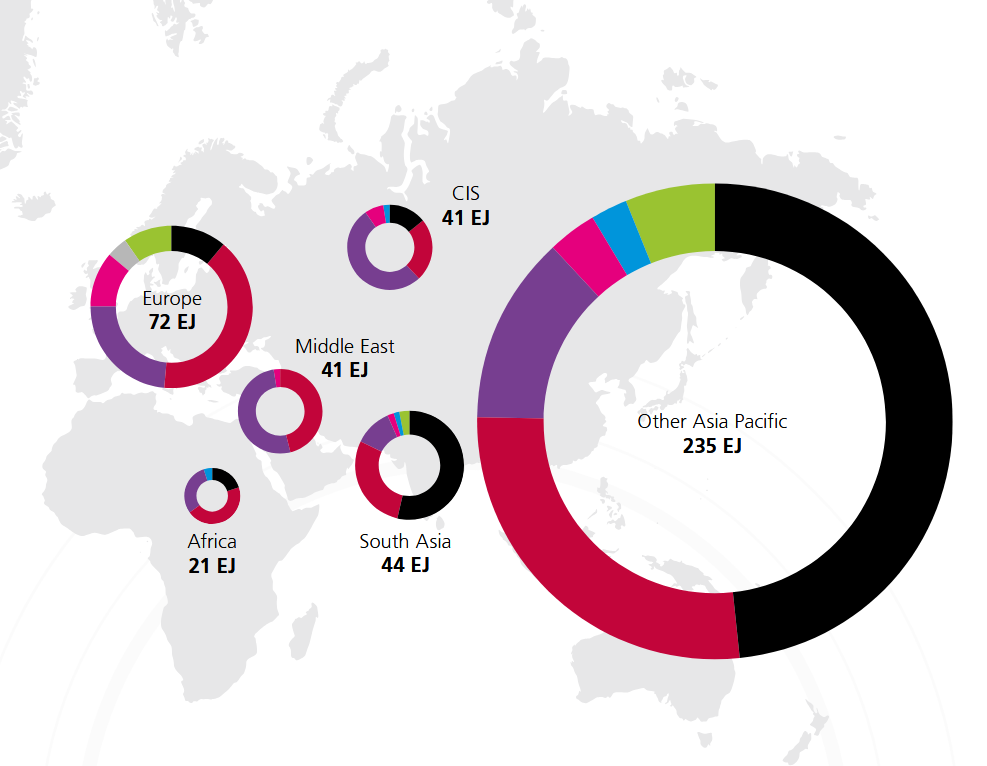Global energy demand grew by 2% last year and reached a new high of 592 EJ.
Information on the latest trends in global energy development, as well as industry statistics for 2024, was published by the Energy Institute (EI) in cooperation with Kearney and KPMG in the 74th edition of the Statistical Review of World Energy.
The analysts visualized the share of each energy source in the global balance in the diagram. The top three are traditionally oil, coal, and natural gas.

Source: Energyinst.org.
The total consumption and contribution of each energy source to the energy balance in different parts of the world is shown below:

Source: Energyinst.org.
Global energy sector trends in 2024
Here are the main points noted by researchers:
- Wind and solar energy together grew by 16%. They strengthened their role as the fastest growing sectors of the energy system.
- China accounts for 57% of new installed capacity, with solar energy in the country nearly doubling in just two years.
- Wind and solar energy grew almost nine times faster than overall energy demand.
- Fossil fuels also grew (by just over 1%).
- Records were set for all types of energy: coal, oil, gas, renewable energy sources, hydro and nuclear energy.
- The growth in demand for electricity was 4% and continues to outpace the growth in overall energy demand, indicating that the era of electricity is not just emerging but is shaping a new global energy system, experts say.
- Demand for crude oil in the Organisation for Economic Co-operation and Development (OECD) countries remained unchanged after a slight decline in the previous year.
- In contrast, in non-OECD countries, where most of the world's growth in energy demand is concentrated and fossil fuels continue to play a dominant role, demand for oil rose by 1%.
- Demand for crude oil in China fell by 1.2% in 2024, indicating that 2023 may have been a peak.
- Global demand for natural gas recovered and increased by 2.5% as gas markets rebalanced after the 2023 downturn.
- Demand for coal in India grew by 4% in 2024 and is now equal to the combined demand for coal in the CIS, South and Central America, North America, and Europe.
“These trends underscore a harsh truth: while renewable energy is scaling faster than ever, global demand for it is growing even faster. Rather than replacing fossil fuels, renewable energy sources are increasing their share of the overall energy mix,” the analysts concluded.
They believe that this pattern, characterized by the simultaneous growth of clean and traditional energy, illustrates the structural, economic, and geopolitical barriers to achieving a truly coordinated global energy transition.
Energy-related greenhouse gas emissions
Analysts noted that global CO₂ equivalent emissions in the energy sector rose by 1% last year to 40.8 Gt. This was another record high – the fourth in recent years.
- Since 2010, renewable energy sources and nuclear power have prevented the emission of approximately 109 Gt of energy-related greenhouse gases, which is about 2.5 times the total global emissions in 2024.
- China remains the world's largest source of greenhouse gases, accounting for about one-third of global emissions.
- Together with India, it accounted for 62% of the increase in global emissions last year.
- For the second year in a row, the US has seen a 36 million tonne reduction in CO2 emissions, which is 0.7% below 2023 levels but below the average ten-year rate of 1% per year.
- Adjusted for COVID, European emissions are declining for the sixth consecutive year and are nearly 16% lower than 10 years ago and three times lower than in China.
As a reminder, in April, solar energy generated a record 10% of the world's electricity.





